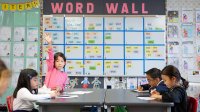Teaching Assertiveness in the Early Elementary Grades
Showing young students when and how to stick up for themselves and others helps build key executive function skills.
Your content has been saved!
Go to My Saved Content.I recently observed a powerful intervention in a kindergarten Zoom class. The teacher and students were discussing ways the children could show their best qualities in school. I assumed the ideas would be things like taking turns, sharing, not calling out, using kind words, etc., so I was surprised when the big one was assertiveness.
My initial reaction was that assertiveness could be good when appropriate but could also represent a type of intrusiveness or entitlement, but in the class assertiveness was depicted through little stories in which characters were confused or fearful, feeling disconnected, or worrying about a classmate; the stories looked at how the characters could remedy those experiences by taking care of themselves and others. In the lesson, assertiveness was about considering what help was needed and speaking up, such as by going to the appropriate adult.
As the lesson unfolded, it became an open-question discussion in which the kinders shared their ideas about what assertiveness is. They built an understanding of it and how to use their assertiveness to take care of themselves and others.
Developing Assertiveness in the Elementary Grades
Assertiveness training can help students have a more accurate perception of their experiences and empower them to deal with distressing situations such as bullying, inappropriate and upsetting behaviors directed at them or classmates, overwhelming instructions, or confusion about lessons or how to follow Covid-19 prevention procedures.
With an understanding of assertiveness and practice building skills, children acquire more effective social awareness and communication options, instead of negative, reactive behaviors such as aggression or withdrawal. The goal is for them to be comfortable and to build skills for effective interpersonal communications such as taking positive action.
Assertiveness and the Developing Brain
Assertiveness, as a behavioral choice, is directed by the brain’s neural networks of children’s developing executive functions in the prefrontal cortex. Executive functions contributing to assertiveness, awareness, and skills include judgment, delay of gratification, emotional self-awareness and self-management, empathy, flexibility of thinking, adaptability, and thoughtful decision-making.
The process of learning—including understanding information and emotional experiences—involves continual remodeling of the brain throughout life via neuroplasticity. The executive function networks’ neuroplastic response is particularly engaged during the elementary school years and is highly responsive to experiences, observations, and practice.
Most remote learning situations, especially for younger students, add stress and reduce the number of direct experiences and opportunities to build social-emotional skills such as empathy and assertiveness. Children miss out on the emotional connections they had in face-to-face interactions with teachers and peer classmates. With less face time with teachers, there is a loss of immediate feedback or timely help when they’re confused or when they want to express their new insights and ideas. However, opportunities can be found for children to build assertiveness and the executive functions they need now more than ever.
Fostering Assertiveness
Assertiveness practice starts with building children’s recognition of situations when it is appropriate to feel concern for themselves and/or others, even if what to do or how to do it is not obvious. In class, and in distance learning, teaching children about the concept of assertiveness is a gradual process, starting with understanding the concept itself.
In the Zoom lesson I observed, the children were guided to recognize the needs of the stories’ characters in distressing situations (e.g., seeing a classmate being bullied). They discussed what might be helpful and built an understanding of assertiveness.
Teachers can help children build assertiveness with empathy awareness and skill-building interventions through the following examples and experiences.
Explore empathy first: Invite children to interpret the meaning of facial expressions as they read books and stories and to reflect on other people’s perspectives as guides to their interactions. Provide chances to evaluate emotional cues—e.g., offer guidance on how to evaluate what a person or character in a story is feeling, and connect that to what actions follow.
Recognize feelings: Suggest situations in which assertiveness could have been or would be helpful:
- How were you feeling when you could not get a partner? What could you have done?
- How did it feel when your friend saw that you were confused about how to find the book in the library and helped you ask the teacher for what you needed?
- What could you do if someone treats you or a classmate in unsafe or mean ways?
Guide play or virtual discussions of “what ifs”: Create role-play situations where students play a variety of character types in order to expand their perspectives, empathy, and awareness of times when assertiveness could be valuable (e.g., bullying, rejection when they want to join a game, being afraid to ask for help).
Practice skills: Model and role-play saying “no” or “I’ll ask an adult” so students get experience asking for help from an adult in those challenging situations.
Teach empathy again: Show how you ask for help or clarification, express concern, or disagree with something in a respectful way.
Sustain connections: You and other adults can guide students when they make missteps. Be an active listener even when they display exaggeration to get attention. Encourage with “I’m so glad you’re letting me know your concerns,” or “What else would you like to say?”
Your efforts to build students’ skill sets for empathy and assertiveness will increase their abilities to care for and about themselves and others, and they will be more able to embrace the challenges and opportunities that lie ahead collaboratively, responsively, and joyfully.
